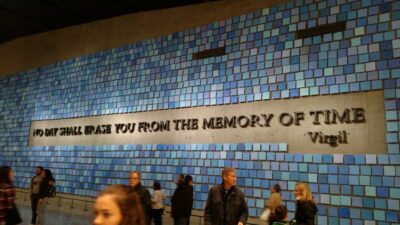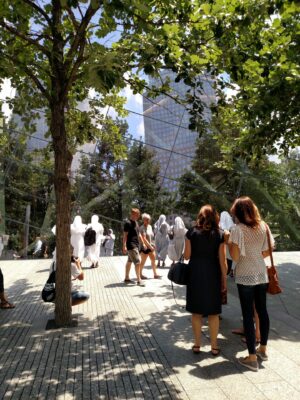“Bearing Witness”: Reflection, Community, and Building Support for Memorial Museum Workers
15 May 2024 – Hillary Moses Mohaupt
Spend an afternoon at the National September 11 Memorial & Museum, a lynching memorial, or a Holocaust museum, and you might emerge exhausted, the heaviness of your visit weighing on your consciousness. Staff at memorial museums that teach about mass trauma experience similar effects, but they are also tasked with protecting the history, memory, and stories that are related to that traumatic past.
“Memorial museums participate in restoring order to communities suffering from mass trauma,” Dr. Stephanie Arel writes in her 2023 book Bearing Witness: The Wounds of Mass Trauma at Memorial Museums. “Workers confront the unthinkability of human-to-human violence, interpreting sites of death and then rebuilding from fragments” (xxvi). In some ways, her argument could be reduced to a remarkably simple yet powerful concept that might apply to workers across the field: museum workers should be adequately trained and sustainably supported in helping visitors process the mental, emotional, and spiritual experience of visiting a historic site. Museums and museum workers can play a key role in commemorating, remembering, rebuilding, and recovering from mass trauma–but only if workers are trained with the right skills.
Arel’s book is an important read for workers at memorial museums in particular, but it is relevant for all museum staff who navigate the impacts of the past on the present. Trauma, Arel explains, is “something that affects the stress system that makes a long-term impact” on workers’ well-being, causing the body to respond as if the suffering were still happening right now. Mass trauma, then, is an event–a genocide, act of terror, or prolonged state of injustice like slavery or apartheid–that invokes a trauma response at a community level. Memorial museum workers face an especially difficult challenge, “work[ing] in a present that continually evokes the traumatic past.’” (51) Arel estimates that about one-third of memorial museum workers are survivors of the trauma that is being preserved and told at these sites.

Photo of Spencer Finch’s installation “Trying to Remember the Color of the Sky on That September Morning” at the National 9/11 Memorial and Museum. Photo credit: Hillary Moses Mohaupt.
Arel, who interviewed 82 workers at memorial museums in eleven countries for her book, brought her interdisciplinary background in theology and applied psychology to studying the experiences of workers at memorial museums. Arel embedded with frontline and administrative staff of the National September 11 Memorial Museum for two years as a post-doctoral fellow. Her background and these interviews provide the foundation for concrete actions she suggests that institutions can take to support these memory workers. She says, “People come with their deepest needs, and the people who work in those spaces are there to mediate all of their experiences and are there to hold all of that.”
Her first site visits and interviews took place in Poland, where she quickly realized that she couldn’t cold-call strangers to ask them about their experiences working in places like Auschwitz. But that’s not her usual approach to interviews anyway. For Arel, theory, feedback from interviews, and other background research are always in dialogue with one another. She takes inspiration from anthropologists like Clifford Geertz, liberation theologians like Paul Ricoeur, and journalists who frequently work with survivors of trauma. “Memory is messy, and who’s telling the history matters,” she explains.
Her interdisciplinary method helped create boundaries that empowered interviewees to remain “the authority of their own experience,” which is particularly important for museum workers who are themselves survivors of the event being memorialized. She organized each interview into three sections, focusing on the history of the interviewees’ work; their own trauma histories; and what they thought the institutions could do better to address issues they raised during the interview. This structure proved especially important in her interviews with museum staff in Cambodia and Poland, where there might have been real political backlash for workers whose comments might be interpreted as being critical of the landscape in which they worked.

Memorial Plaza, National 9/11 Memorial & Museum. Photo credit: Hillary Moses Mohaupt.
There are three keys areas in which memorial museums can offer support to staff at all levels: building skills, developing an intentional sense of community, and offering opportunities for intense and regular reflection. For many museums, funding and sustaining these options requires a cultural shift within the organization that recognizes this emotional labor as critical and central to its mission. Building skills can empower people, especially those who experience trauma, to feel increased agency and repair trauma’s effects–even if the skills have no direct connection to their work. Memorial museums facilitate mourning for individuals and communities, and processing grief and navigating trauma require specific skills that aren’t taught widely, much less in museum studies programs.
It can be difficult to establish boundaries when faced with retelling painful histories multiple times each day. That’s why it’s paramount that administrators foster a work culture of “reflection and awareness.” Museum leaders should acknowledge the needs of workers in different departments (for example, tour guides may need different support than exhibit specialists or object curators), provide specific training and education for those departments, and enforce healthy boundaries with work.
Theologian Fredrich Buechner defines a vocation as the place where your deepest calling reaches the world’s greatest need. If we’re lucky, we find ourselves in roles that allow our passion to intersect with a community’s needs–and we’ll be supported in that role. Arel notes that for many of the workers with whom she spoke, memorial museum work represented a vocation in this sense. But passion is not an excuse to not provide adequate support for workers who are navigating the real, palpable grief of the people who visit these spaces.
“Attending to human suffering is painful, but it has quite a reward because it’s about helping people,” Dr. Arel says. “The more these workers can be supported and the more they can promote their own wellbeing, the more they can do tikkun olam, repairing the world.”
~ Hillary Moses Mohaupt is a freelance writer in Delaware. Instagram and Twitter/X: @_greyseasky_



